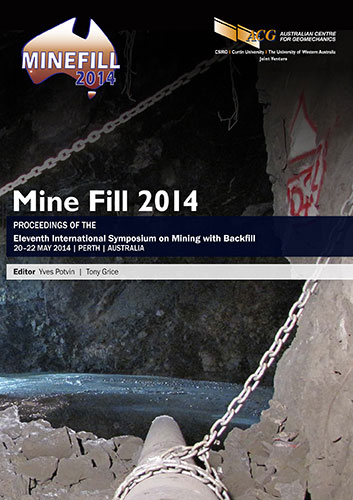Study on the stability of bulk backfill mass above 1,150 m horizontal pillar at Jinchuan No. 2 Mining Block

|
Authors: Peng, F; Li, S; Hu, J; Wang, H; Zou, L; Gu, D Paper is not available for download Contact Us |
DOI https://doi.org/10.36487/ACG_rep/1404_35_Peng
Cite As:
Peng, F, Li, S, Hu, J, Wang, H, Zou, L & Gu, D 2014, 'Study on the stability of bulk backfill mass above 1,150 m horizontal pillar at Jinchuan No. 2 Mining Block', in Y Potvin & T Grice (eds), Mine Fill 2014: Proceedings of the Eleventh International Symposium on Mining with Backfill, Australian Centre for Geomechanics, Perth, pp. 449-458, https://doi.org/10.36487/ACG_rep/1404_35_Peng
Abstract:
The Jinchuan No. 2 Mining Block is a large and thick orebody with a strike length of 1,300 m and an average width of 118 m. It is a typical difficult deposit for mining due to high in situ stresses and broken ground conditions in both the orebody and the surrounding rock mass. Mechanised panel and underhand cut−and−fill drift stoping method is used in the mine. After more than 30 years of mining, a horizontal pillar around 20 m thick (1,300 m long and 118 m wide) was left between 1,150 and 1,170 m, and backfill masses of 10 million and five million cubic metres were placed above and below this pillar respectively. In order to recover the high grade mineral resources, mining of this horizontal pillar commenced in 2003. The premise of the pillar excavation was based on the stability of the bulk backfill mass above the pillar. The severe surface subsidence and deformation of the surrounding rock masses caused a high concern for the stability of the bulk backfill above 1,150 m. This paper focuses on the stability of the bulk backfill during the extraction of the pillar. Based on the analysis of the deformation characteristics of the bulk backfill, scores of monitoring instruments were laid out within mined and filled areas of the pillar and country rock. Displacement meters developed by the project team were used to measure vertical deformation of the bulk backfill mass of 50 m high between 1,150 and 1,200 m, whilst a levelling survey was used to monitor the unitary vertical displacement of the bulk backfill mass and the surrounding rocks. At the same time, the stress and displacement monitoring in the surrounding rock at 1,100, 1,150 and 1,200 m were also carried out. The monitoring results showed that: Finally, the basic conclusions are given on the stability of the bulk backfill mass whilst mining the pillar.
References:
Gao, J & Yang, C 2003, ‘Deformation rule of wall rock and filling in deep stope in deposit 2 of Jinchuan’, Chinese Journal of Rock Mechanics and Engineering, vol. 22, supp. 2, pp. 2625-32.
Jinchuan Non-ferrous Metals Company & Changsha Institute of Mining Research 1990, Experiment study on mechanism of action of bulky backfill by using downward strip cut and backfill stoping method of No. 1 ore body in Jinchuan No. 2 Mining Block, Jinchuan Non-ferrous Metals Company, Jinchang & Changsha Institute of Mining Research, Changsha.
Jinchuan Non-ferrous Metals Company & Jinchuan Branch of the Chinese Society for Rock Mechanics and Engineering 1996, Engineering geology and rock mechanics problems of mining in Jinchuan, Jinchuan Non-ferrous Metals Company, Jinchang & Jinchuan Branch of Chinese Society for Rock Mechanics and Engineering, Jinchang.
Li, X, Lu, S & Liao, Q 2006, ‘Distribution characteristics and field monitoring of ground fissures caused by backfill mining’, Chinese Journal of Rock Mechanics and Engineering, vol. 25, no. 7, pp. 1361-9.
Ma, C, Mu, Q & Xu, Y 2005, ‘Yield process of the 1150 m horizontal jamb in Jinchuan No. 2 Mining Block’, Chinese Journal of Geotechnical and Engineering, vol. 30, no. 3, pp. 361-5.
Ma, F, Yuan, R & Deng, Q 2007, ‘GPS monitoring of ground movement and mechanism of underground mining influence in Jinchuan mine’, Journal of Engineering Geology, vol. 15, supp. 2, pp. 84-97.
Peng, F, Wang, H & Li, S 2013, ‘Wide range of pressure monitoring scheme and preliminary analysis in Jinchuan No. 2 Mining Block’, Metal Mine, vol. 42, no. 4, pp. 15-8.
© Copyright 2026, Australian Centre for Geomechanics (ACG), The University of Western Australia. All rights reserved.
View copyright/legal information
Please direct any queries or error reports to repository-acg@uwa.edu.au
View copyright/legal information
Please direct any queries or error reports to repository-acg@uwa.edu.au